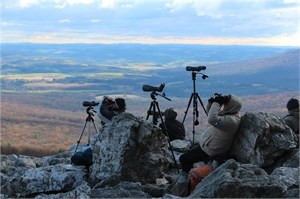Raptor count ends but hawks still passing
Posted on January 07, 2016 in Science

Although the annual raptor migration count at the world-famous Hawk Mountain Sanctuary in Kempton, Pa, concluded December 15, Sanctuary biologists say the hawks will continue to move south thanks to the unseasonably warm weather this fall.
“Some late season migrants lingered to our north and are just starting to move now,” says Senior Monitoring Biologist Dr. Laurie Goodrich. “That makes January and February a great time to visit, especially to watch for red-tailed hawks and bald eagles,” she says.
The 2015 count, which concluded December 15, tallied 13,419 birds of prey, 30 percent below numbers typically seen during a fall season and with no records for any species. In fact, only bald eagles and merlins came in above their 10-year-average while the rest of the 16 species that pass the Sanctuary fell below average, some as much as 65 percent below.
Scientists say it may just be an off year, one plagued by a lack of cold fronts, the one weather condition that birders count on to gather migratory raptors along the ridge. With many days of east winds, September counts were low and the cloudless, blue skies during the peak of broad-winged hawk migration made spotting the high-flying, broadwings nearly impossible.
For late-migrating species, such as the red-shouldered and red-tailed hawk, a lack of snow cover to the north allowed the birds to linger at a time when large numbers would usually be seen soaring by Hawk Mountain in late October through November.
Despite the below-average counts, the Sanctuary did report some highlights: a Mississippi kite passed on September 25, only the fourth fall record and ninth record overall for the Sanctuary, and on October 4, an adult light-morph Swainson's hawk was counted, the 19th record for the Sanctuary. Eleven peregrine falcons were spotted on October 1, the fourth-highest, single-day count in Hawk Mountain history.
“Looking back, the warmer weather may have made some migrants linger, but it also stretched our unofficial season. Balmy days during November and December get more people spending time outside and we saw an increase in visitation overall,” Goodrich explains.
An additional 54,966 non-raptors were also tallied including 11,189 Canada goose, 8,486 common grackles, 6,489 cedar waxwings, 1,948 American crow, 1,717 red-winged blackbirds, 812 monarch butterflies and 327 dragonflie. The most unusual non-raptor was a summer tanager on September 15, only the second record since the 1940s for this more southerly tanager, but overall, warbler and vireo counts were below average. Some of the more unusual species seen included blue-winged, yellow, and prairie warbler. Crossbills were seen sporadically from late October through November including a high of six red crossbills on October 31 and a single white-winged crossbill on November 3. Other highlights included 117 common loons on November 14, 35 ruby-throated hummingbirds on August 27, 64 ruby-crowned kinglets on October 6, and 4,398 common grackles on November 7.
As the world's first refuge for birds of prey, Hawk Mountain Sanctuary has long been considered the destination for hawkwatch enthusiasts. Located on the Appalachian Flyway, the rocky overlooks at Hawk Mountain provide an ideal location to enjoy, study, and learn from the spectacle of raptor migration.
Why Count Hawks?
Hawk Mountain Sanctuary has conducted bird migration counts since 1934. Its database represents the longest-running record of hawk migration in the world. The long-term data allow scientists to monitor the conservation status of these normally secretive birds. Declining trends in any one raptor population can alert conservationists to potential problems in the environment.
In addition to its scientific value, Hawk Mountain educators use the hawk count to introduce thousands of schoolchildren and an average 70,000 visitors to the phenomena of migration and the importance of conserving birds of prey. The Sanctuary also uses the annual event to train young conservationists from around the world and teach them how to monitor wildlife, record and analyze data, and interpret the migration for the public.
Lookouts and trails at the sanctuary are open dawn to dusk daily and are located along Hawk Mountain Road, 7 miles north of the I-78/Rte 61 intersection near Hamburg. The Visitor Center is open 9 am to 5 pm daily. Trail fees cost $9 for adults, $8 for seniors and $5 for children aged 6-12. Sanctuary members and children under six are admitted free, with family memberships costing $50 for year-round admission.
For more information on birds of prey and Hawk Mountain Sanctuary, visit www.hawkmountain.org.